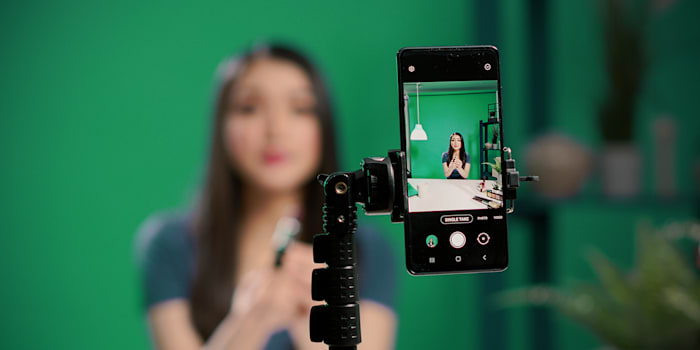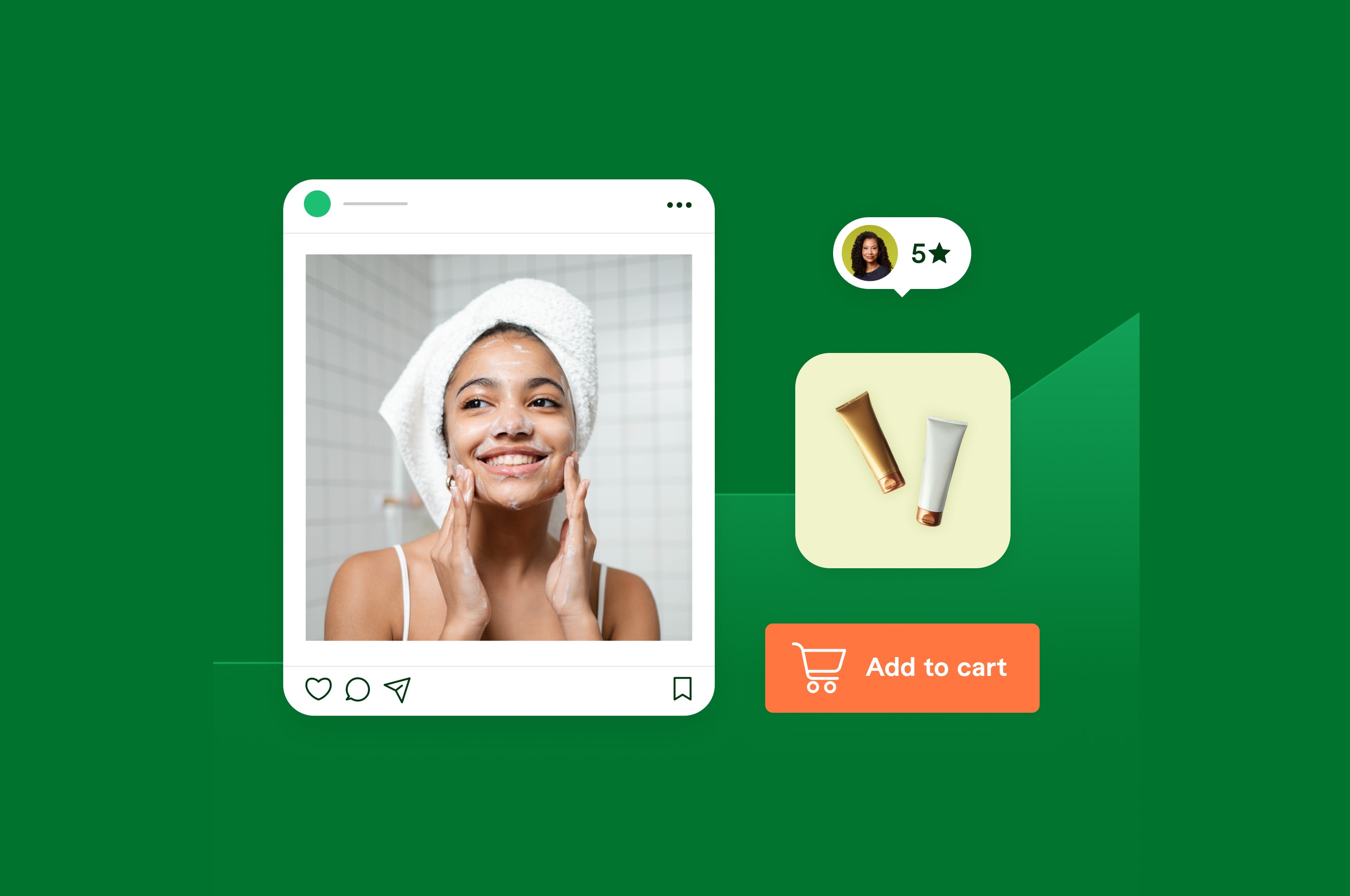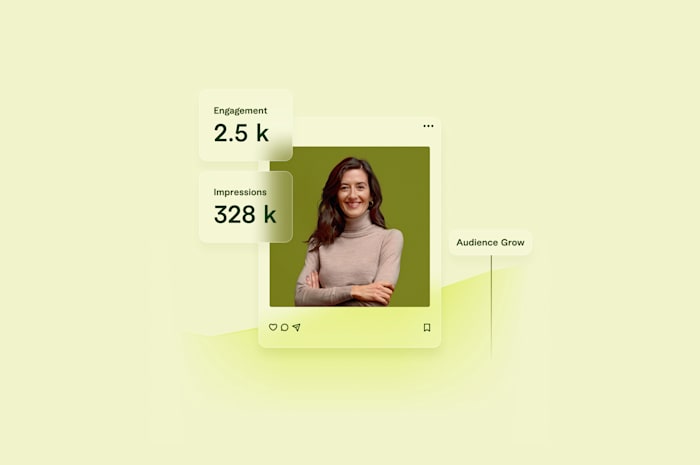What Is User-Generated Content (UGC) and How to Use It
What exactly is user-generated content? Learn more about the different types of UGC, with examples and a guide on how to create a successful UGC campaign.
 December 27, 2024
December 27, 2024 10 minute reading
10 minute reading
Companies are always looking for ways to better appeal to their target audience, and user-generated content (UGC) videos are a great way to do just that. By gathering and sharing content that a company’s existing customers have created, they’re able to showcase a more “real” product experience than their own promotional content does.
There are many different types of user-generated content that brands can explore, each of which we’ll be covering in this article, along with how to create a UGC campaign that increases awareness and conversions.
What is user-generated content (UGC)?
User-generated content (or UGC for short) is a marketing tactic where businesses share content their customers create. This strategy uses social proof, a concept in marketing psychology, showing that consumers are more likely to choose a business they see others are happy with.
With UGC, a business’s real-life customers share photos, videos, and other types of content onto their own platforms for their audience to see. This gives the featured brand a unique opportunity to re-share that content onto their own channels.
UGC is a great content marketing tactic for increasing awareness, customer engagement, and conversion rates. However, it often takes a UGC marketing campaign to strategically gather enough content to incorporate into your regularly scheduled content.
The value of using UGC in marketing
User-generated content is the perfect kind of content to share when working to build authentic relationships with your target customer base.
According to Shideh Kaviani, president of global womenswear brand Naked Wardrobe, “UGC makes your brand feel more real and relatable to your audience. With UGC, people are seeing your brand existing in the real world, a world that they live in, thus allowing your brand to feel more applicable to them and their lifestyle.”
Other reasons that UGC is so valuable include:
90% of consumers prefer to see brand content from actual customers. Your audience wants to see you sharing UGC.
81% of consumers, according to the same study referenced above, aren’t impacted (or are negatively impacted) by influencer content. Working with UGC creators can influence purchasing decisions more than influencers.
85% of consumers say they rely on UGC video before making a purchase, and 75% added that they trust UGC video over any other type of UGC. More than that, 81% of consumers say they trust UGC video over regular branded content, which is good for word-of-mouth marketing.
Engagement is 16x higher when a creator posts on behalf of a brand compared to a brand’s average engagement (4.8% engagement rate versus 0.3%).
This shows that people love user-generated content, and as a brand, you have the opportunity to deliver what they’re excited about.
Types of UGC
There are five main types of user-generated content that you can gather and share. Here are some examples of each one.
Testimonials
The first type of UGC is customer reviews or testimonials—another amazing form of social proof. What’s better than a potential customer seeing a rave review right at the top of your social media feed, letting them know how much another customer loved your products?
Take a look at how skin care brand eos shares top reviews of its products on its Instagram:
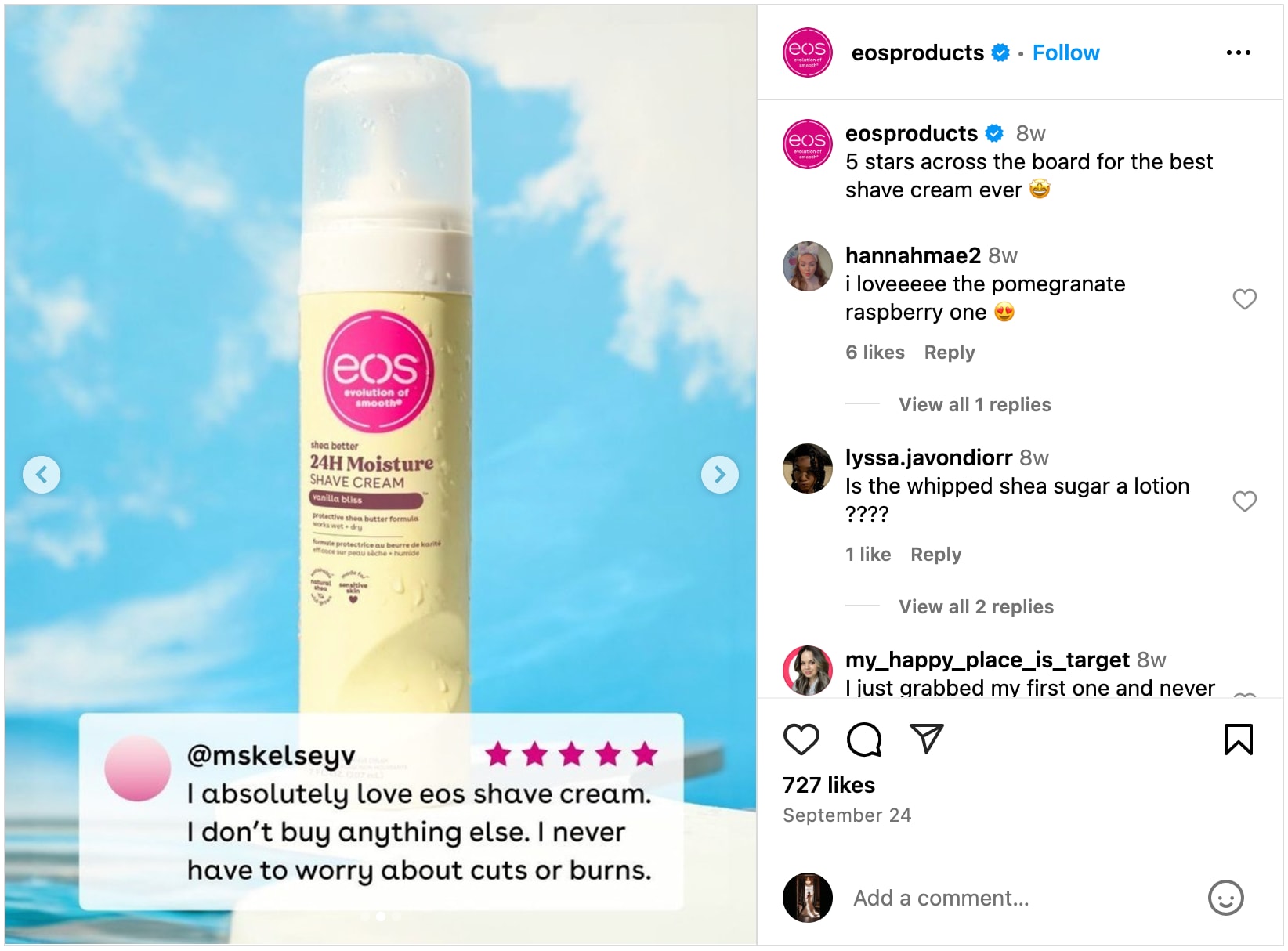
eosproducts Instagram
Take screenshots of your reviews to share on other platforms or create graphics that can help you showcase your happy customers.
Photos
Photos are probably one of the most common (and easy to gather) types of UGC. These simply consist of images that your customers have taken of your product or using your product.
Here’s a UGC example photo shared by Book of the Month, which was taken by one of its subscribers:

Book of The Month Instagram
Keep an eye on potential user-generated content by looking at your brand’s tags or creating a branded hashtag that your audience can use when they post.
Videos
As Instagram Reels, TikTok, and other video platforms become more popular, you may find that more customers are creating user-generated videos instead. Video content is amazing because it provides an even better view into your product than a simple image.
Here’s an example from Pottery Barn of what a UGC video could look like. One of its customers shared a video of her family putting up a Christmas tree using Pottery Barn products.

Pottery Barn Instagram
Other types of videos UGC creators produce are:
Case studies
Product reviews
Video has a much bigger impact than a simple image would. Incorporating video into your UGC strategy should be a priority.
Hire UGC video creators
Blog posts
Blogging is still a powerful type of UGC. A blog post helps potential customers learn more about your product by combining different types of UGC—like photos, videos, and written content—in one place.
Here’s an example of a blog post highlighting a product from Graco, giving the baby brand an incredible piece of content to use:
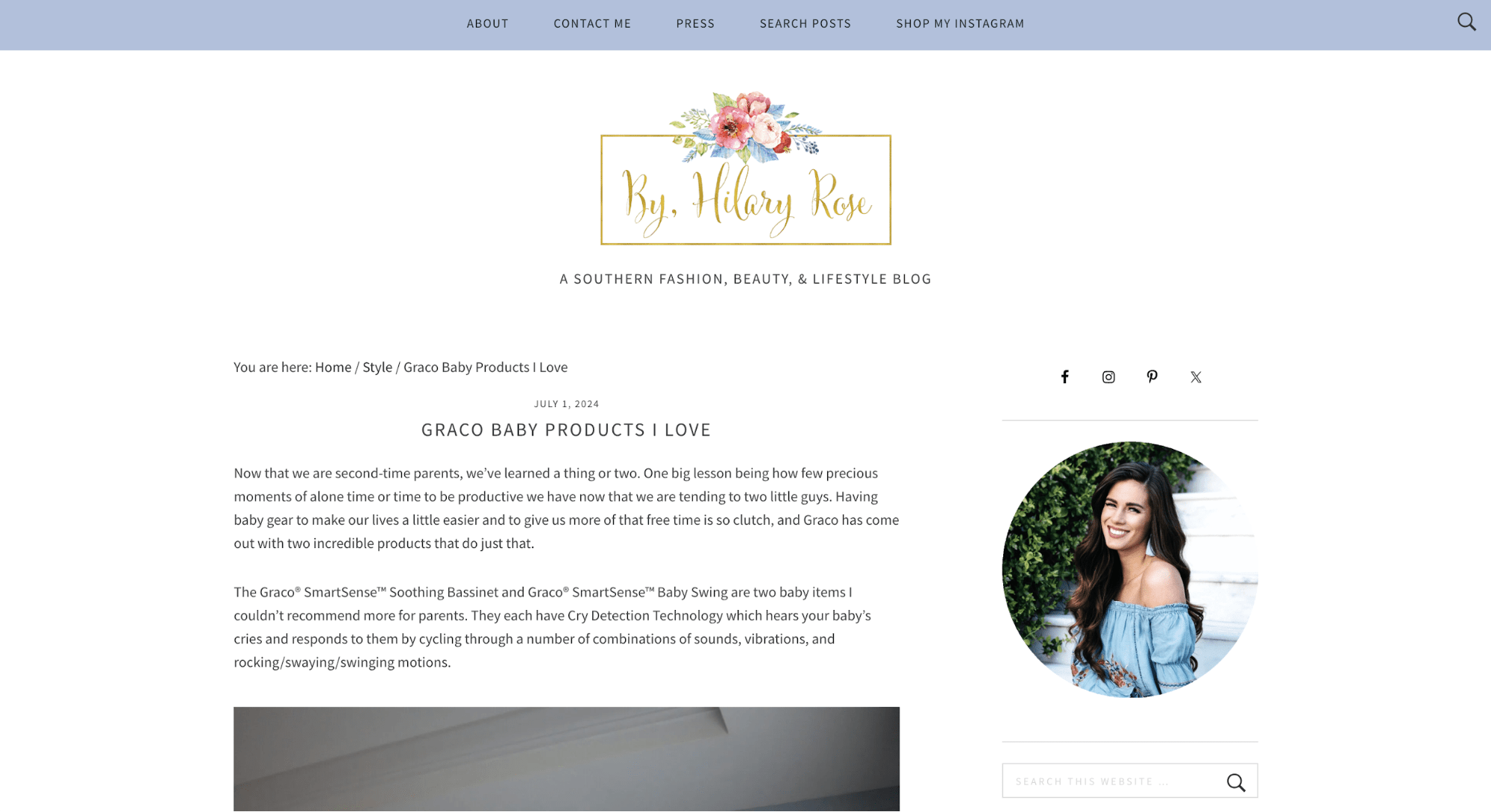
By Hilary Rose Website
The blog post dives into what the influencer likes about the product while sharing photos of it. The blogger likely created this post to generate affiliate revenue. One way to increase the chances of getting your own UGC blogs is by creating or participating in an affiliate program.
Paid UGC
Finally, we have paid UGC. While, of course, we all want to gather a library full of organic UGC, that can take time. Paid UGC ads are a great way to get started.
Take a look at this TikTok ad from dog food brand Blue Buffalo, created by a TikTok influencer and promoted as a UGC ad:

Adria & Oatmeal TikTok
This type of ad feels more authentic than a brand-created ad. So even though this is a form of paid advertising, it creates a much bigger impact because it looks like organic UGC.
How to create a UGC campaign
Want to get started gathering and sharing your own user-generated content? Creating a UGC campaign is a great way to improve your marketing efforts by working with real people.
Follow these steps to get started with your first UGC campaign:
1. Define the campaign goal
As with any social media marketing campaign, you need a set of goals that will define how you gather UGC, the types of UGC you promote, and your re-sharing strategy.
Some common goals for a UGC campaign include:
Raising brand awareness, a specific product, or a product collection (especially during a launch phase)
Boosting engagement and getting your audience talking about your brand, products, and/or industry
Generating more sales and conversions directly from your social media efforts
A goal matters because it will impact the type of UGC you share.
For example, if you want to raise awareness, sharing any kind of photo or video with product placement can do the trick. But if you’re looking to generate sales, you’ll want content that speaks on your product—and you may even want to get some paid UGC created.
2. Decide on your social media platforms
Next, select the social media platforms you plan to use for your UGC campaign. Instagram and TikTok are the two most popular social networks for this type of content, but you can develop strategic uses for other platforms, like X/Twitter or even LinkedIn.
To choose your social media platforms, consider:
Where your target audience is active
Where customers share UGC
Where you have the largest reach
You might even choose to focus on a single platform to start so that you can easily measure performance before expanding your strategy.
3. Connect with UGC creators
Your strategy can focus on gathering UGC organically by creating a branded hashtag or offering some kind of incentive to your customers. However, if you want a hand in content creation, connect with UGC creators and work with them.
One great way to find top-tier partners is through an online marketplace like Fiverr. Search for video creators to produce authentic, relatable content showcasing your brand and products.
4. Create content at scale
Next, start creating content. While you’ll want to start small, selecting just a couple of UGC creators to see how the videos turn out, you can easily scale the project by hiring more creators or working with your select few to build out even more content ideas.
Follow these tips to make sure you’re generating content that aligns with your brand and resonates with your audience:
Put together a budget based on average influencer marketing costs
Create guidelines you can share with UGC creators so they know what to highlight and what kind of voice or messaging to use
Read reviews and look at portfolios of the creators you’re considering hiring
Start with a single project to make sure their content aligns with your goals and your vision
Scale up your project by hiring more creators
Once you have your content, it’s time to start publishing. You can share it organically on your feed or create ads to make sure you’re reaching your target audience.
5. Monitor content performance
The last step is simply to measure how the UGC performs. Are you reaching your goals? Is your target audience receptive to your videos?
The KPIs you monitor should align directly with your goals. For example:
Building awareness means you’ll need to monitor reach and following
Increasing engagement relates to interactions like comments, shares, and likes
Generating sales means looking at clicks and conversions
You’ll also want to pay attention to sentiment. Does your audience seem to be enjoying your videos? If not, you may need to switch gears and find a new approach.
Examples of UGC
Let’s look at some examples of user-generated content in action. Seeing how other brands work with UGC can be inspirational for your own strategy.
Lovevery
Lovevery is a child development brand that sells products meant to help babies learn and grow. While its feed tends to focus on branded promotional content, the brand does a great job of showcasing real customers throughout its Instagram stories.
We can see below three Reels that Lovevery’s customers shared onto its story of the brand’s products in use by their kids:
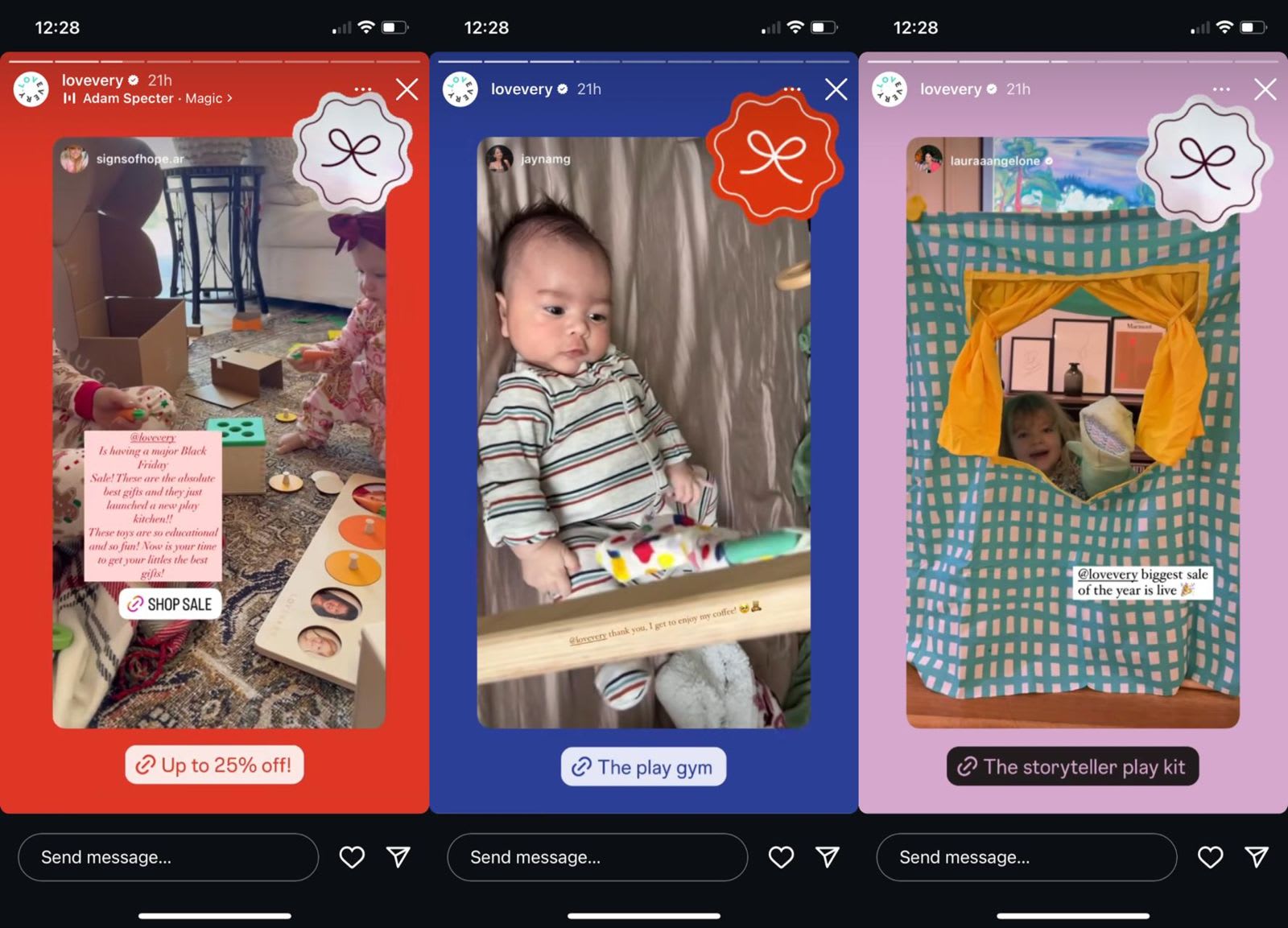
Lovevery Instagram
Sharing Instagram posts on your story that mention your brand is a simple way to share UGC with very little effort. This way, you don’t have to put together a process for getting permission to share the content as it’s a built-in sharing feature on Instagram.
Plus, you can still keep your Instagram feed strategy going without interrupting it with UGC, while still seeing the benefits of this type of social media content.
Away
Suitcase brand Away uses UGC to engage its audience with travel-related content. While the videos it shares don’t necessarily mention its brand, they are humorous videos about traveling, like this example about “laying eyes on the gate.”
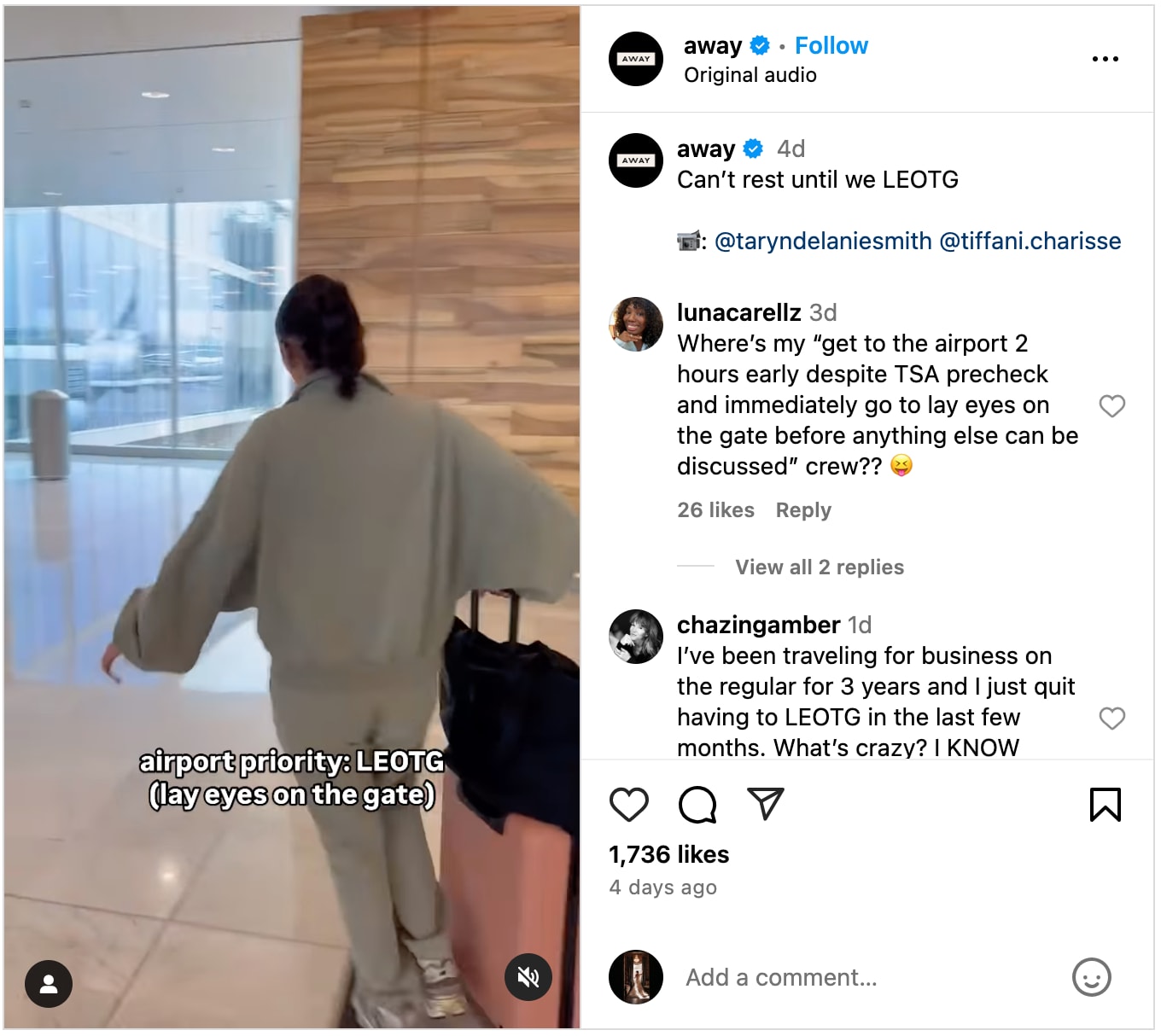
Away Instagram
Your brand can take a similar approach by sharing content that influencers in your niche have shared. This can be a fun way to increase audience engagement and grow your following.
Doritos
Chips brand Doritos gives us a great example of UGC on TikTok with this video below. Doritos used a TikTok feature called “stitching,” where they take their own video onto an existing TikTok video.
The video Doritos stitched asked the question, “What’s a video that lives in your head rent free?” and answered by sharing one of the brand’s old commercials.
Doritos TikTok
Stitching and dueting, another TikTok feature, is a great way to combine user-generated content and your own branded content in a fun and engaging way.
Olipop
Soda brand Olipop shares customer photos on its Instagram feed every so often. In the example below, the brand put together an image carousel post with several UGC images from its customers.
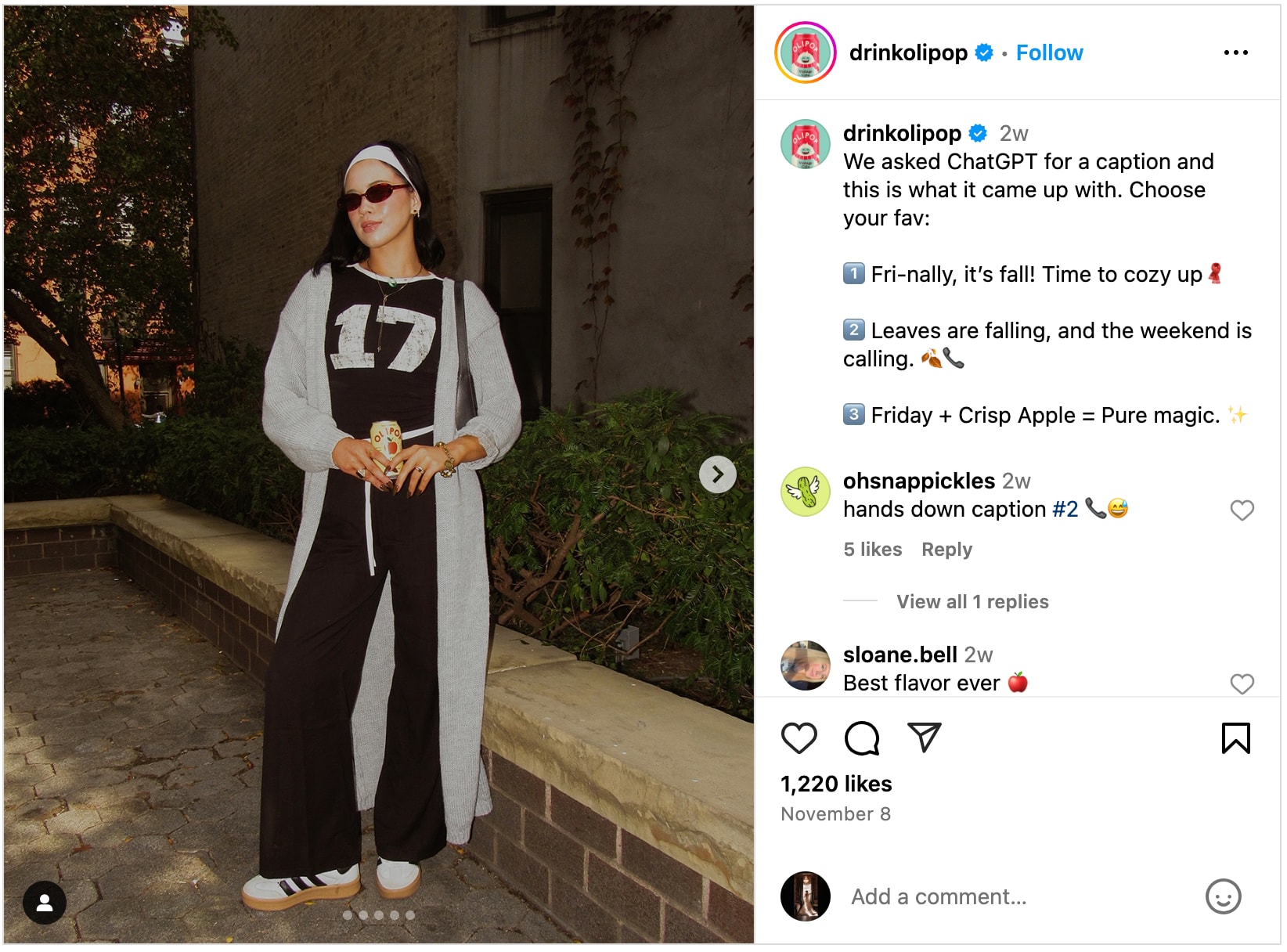
Drink Olipop Instagram
This is a great way to incorporate UGC into your Instagram marketing strategy without having to make major adjustments.
Hydro Flask
Water bottle brand Hydroflask shared this post below, which is a sort of haul video that includes products from several different brands—Hydro Flask included. Haul videos typically feature a number of different brands and products and are often done by influencers showing off free products they received from brands or a big haul after a shopping spree.
By featuring how its products fit in nicely with a “brr basket,” a wintery social media trend, Hydroflask is encouraging purchases for its audience’s own versions of a brr basket.
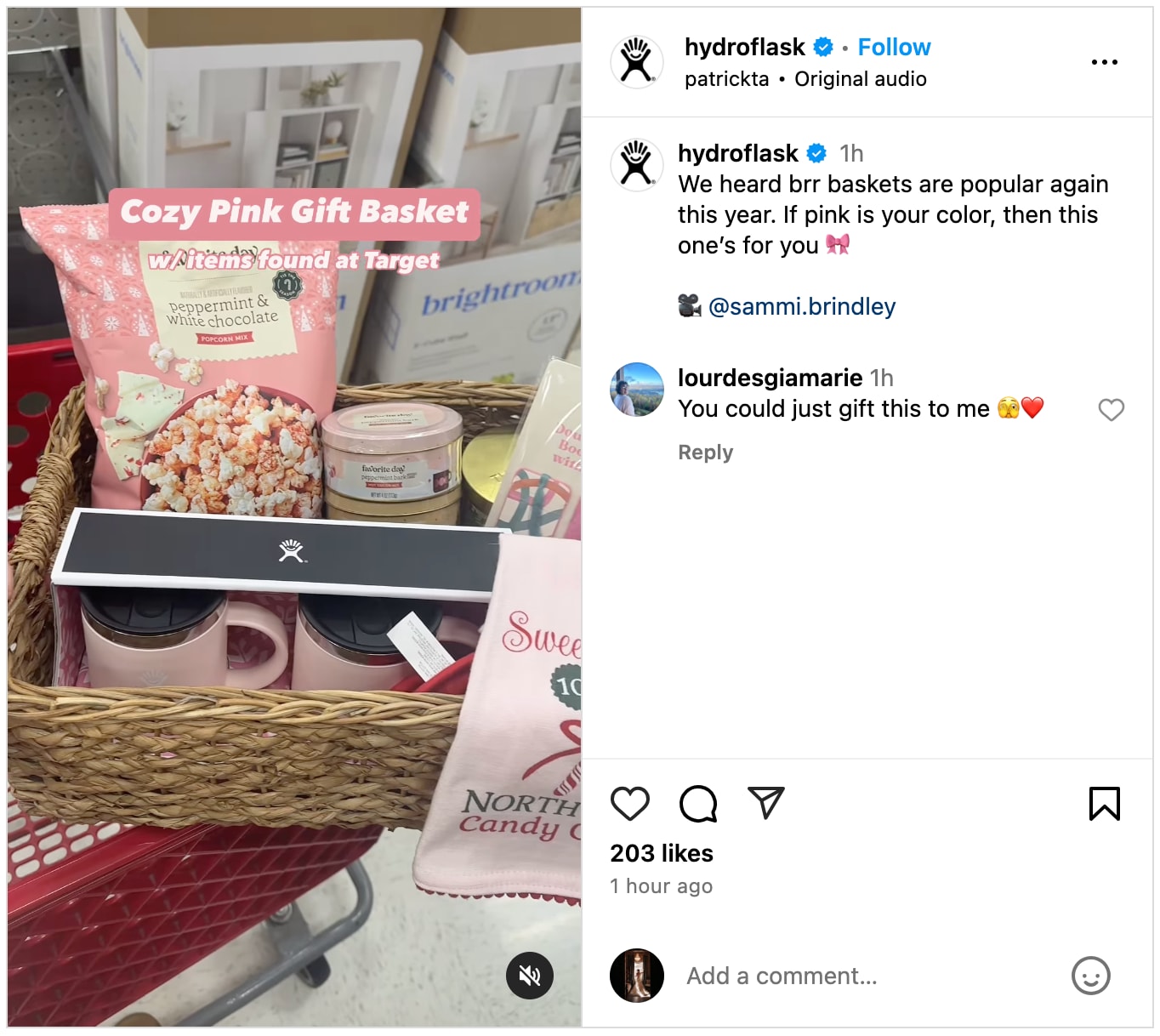
Hydroflask Instagram
If you find your product featured in a similar type of video, this is a perfect opportunity to re-share it with your own audience.
Buy and sell UGC services on Fiverr
Let Fiverr help you on your UGC journey. Both businesses and creators can benefit, with brands able to find creators to work with and content creators getting the opportunity to find companies to work with.
Get started with the right UGC video partner at Fiverr today.
UGC content FAQ
What do you mean by user-generated content?
User-generated content is an image, video, or other piece of content created by a company’s customer. The customer enjoyed a product so much that they showcased it in a photo or video and shared it on their social media channel.
Brands will often look out for social media posts like this to share with their audiences as it’s a much more authentic type of content than their own promotional content.
What is an example of user-generated content?
An example of user-generated content is a customer posting a photo on Instagram of themselves using a brand’s product, such as a coffee mug, with a caption tagging the brand. Then, the brand reposts it on its social platform of choice. The power of UGC lies in its ability to create brand ambassadors and build a sense of community around its products.
Can you actually make money doing UGC?
Yes, digital creators can actually make money by partnering with brands to create various types of UGC. Called a UGC creator, this newer role is a great way for influencers and content creators to bring in more revenue.
What is UGC and how does it work?
UGC, or user-generated content, is a content strategy where companies share content created by their customers. It works by showcasing happy customers using products, a cost-effective marketing tactic that builds trust, improves brand loyalty, and drives sales.
